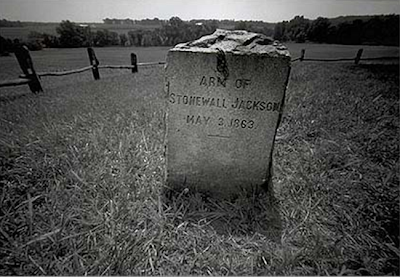
 Sometimes a gravestone is not what it looks like. There are a handful that mark remains - but not a complete set! The photo at the top is the multi-purpose marker of William and Desire Tripp's infant children Wait (d. 1780) and William (d. 1784), but also of Desire's arm, which was amputated in 1786. The second photograph depicts the stone marking the burial of the arm of Stonewall Jackson (1824-1863) on the Wilderness Battlefield in Virginia. Other examples of limb burial include the leg of Captain Samuel Jones, lost in a construction accident and laid to rest in Washington, New Hampshire, in 1804, and the leg of Confederate general Richard S. Ewell, lost and buried at Groveton, Virginia, in 1862. According to one account, a belief existed that properly arranging and aligning a severed limb would ensure less pain in the stump. This account from Vermont doesn't mention the orientation, but does describe the careful placement of a leg lost to a logging accident. After his leg was hit by a cannonball in battle and amputated in 1842, Mexican president General Santa Anna (1794-1876) buried it with full military honors and entombed it in the Pantheon of Saint Paula - but it was stolen during riots 2 years later and never turned up. Centuries earlier, Scottish knight Sir William Wallace (1272-1305) was drawn and quartered for treason in London, after which his head and limbs were displayed separately as an example; Aberdeen got an arm, and a star on the wall of St. Machar's Cathedral marks the spot where it was interred. But perhaps the strangest story was reported by the New York Times in 1899: the burial of a city resident's amputated leg required a death certificate signed by the undertaker and the surgeon stating that "Peter Conroy's remains" had died a natural death - which left some question regarding the rest of Mr. Conroy, who was recuperating at Bellevue Hospital!
Sometimes a gravestone is not what it looks like. There are a handful that mark remains - but not a complete set! The photo at the top is the multi-purpose marker of William and Desire Tripp's infant children Wait (d. 1780) and William (d. 1784), but also of Desire's arm, which was amputated in 1786. The second photograph depicts the stone marking the burial of the arm of Stonewall Jackson (1824-1863) on the Wilderness Battlefield in Virginia. Other examples of limb burial include the leg of Captain Samuel Jones, lost in a construction accident and laid to rest in Washington, New Hampshire, in 1804, and the leg of Confederate general Richard S. Ewell, lost and buried at Groveton, Virginia, in 1862. According to one account, a belief existed that properly arranging and aligning a severed limb would ensure less pain in the stump. This account from Vermont doesn't mention the orientation, but does describe the careful placement of a leg lost to a logging accident. After his leg was hit by a cannonball in battle and amputated in 1842, Mexican president General Santa Anna (1794-1876) buried it with full military honors and entombed it in the Pantheon of Saint Paula - but it was stolen during riots 2 years later and never turned up. Centuries earlier, Scottish knight Sir William Wallace (1272-1305) was drawn and quartered for treason in London, after which his head and limbs were displayed separately as an example; Aberdeen got an arm, and a star on the wall of St. Machar's Cathedral marks the spot where it was interred. But perhaps the strangest story was reported by the New York Times in 1899: the burial of a city resident's amputated leg required a death certificate signed by the undertaker and the surgeon stating that "Peter Conroy's remains" had died a natural death - which left some question regarding the rest of Mr. Conroy, who was recuperating at Bellevue Hospital!








No comments:
Post a Comment
You may add your comments here.